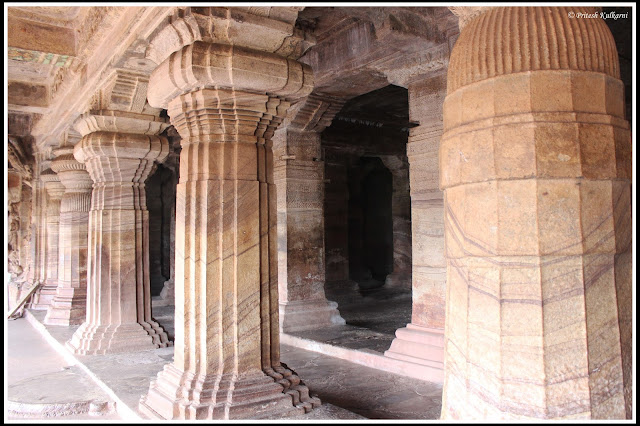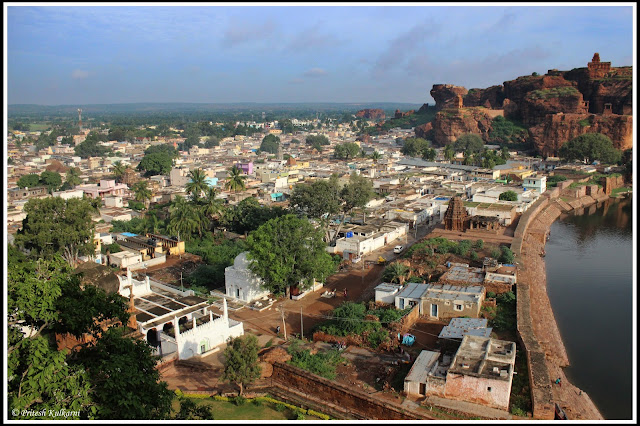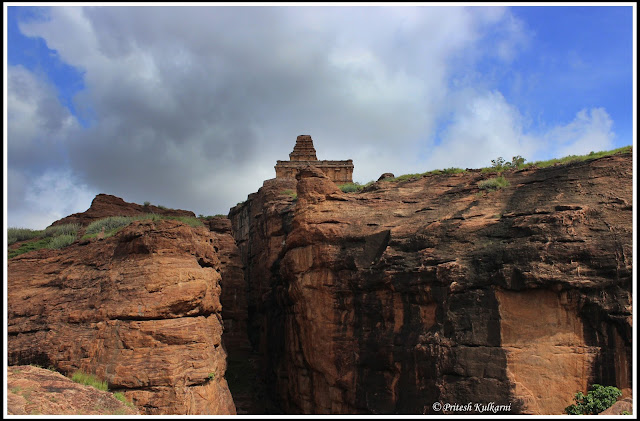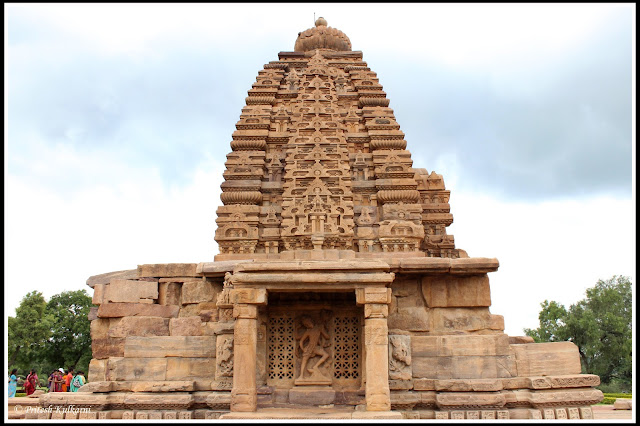We went on a road trip to Karnataka in February 2015; however, due to time constraint, we were unable to visit one of the best archaeological sites Badami and Hampi. Both places were on our must-visit list and finally, we planned in October.
Travellers for this trip were me and wife Renuka.
 |
| Bhuthnath Temple, Badami |
About Badami – Pattadakal – Aihole
Badami was known as Vatapi and was the regal capital of the Badami Chalukyas from 540 to 757 AD. Mainly it is famous for its rock cut structural temples and beautiful location around Agasytha temple. Pattadakal is a world heritage site and just 22 km from Badami and about 10 km from Aihole. Group of temples from a different period of time are a major attraction. Aihole village has a historic temple complex from Chalukyas Empire.
Our trip plan/Route was Pune – Gokak – Badami – Pattadakal – Aihole – Hampi – Hubali – Pune.
Day 1: 2nd Oct 2015: Pune – Gokak – Badami:
Our journey began at 5 AM as we wanted to avoid the highway traffic and enjoy the morning breeze. The National Highway 4 was in excellent condition and well suited for a long drive. During our road trip to Karnataka, I was the solo driver as Renuka had met with an accident and fractured her hand. For this trip, most of the time she was on driving seat. At Karad, we took a break for snacks and coffee.
When we entered in Karnataka, we thought to visit Gokak to see the waterfall. It is generally best to visit during peak monsoon but we decided to visit anyway. We reached at Gokak fall by 10 AM. There is a huge hanging bridge on fall to cross the riverside. The waterfall is on Ghataprabha River. The waterfall is horseshoe shaped and flooded during peak rainy season resembling Niagara Falls on a smaller scale. At this time of the year, there was less water flow in the fall but still, it was beautiful to watch. We spent some time near the waterfall and started our journey towards Badami. Mountains nearby Gokak are of the rocky valley. It gives you the feeling that you are going to Badami-Hampi to witness the Chalukyas era.
 |
| Gokak Waterfall |
Our route to Badami was as suggested by google map. The route was yaragatti – Lokapur – Mattikatti – Badami. Even though the entire route was by the state highway but very wide and smooth road gave us an excellent driving feel. Renu enjoyed countryside drive. We had our lunch in one of the villages. It was clean, tasty south Indian menu. Even after eating delicious 2 Masala Dosa, 2 uttapa and cold drinks, our bill was just around INR 100/-.
Light rain shower welcomed us when we were about to reach Badami. We reached Badami by 4 PM. We were enjoying our ride hence reached a bit late than the scheduled. It was a bit cloudy when we reached Badami. We checked a few hotels and then booked in Hotel Rajsangam which is opposite to Badami Bus stand. As the closing time for Badami cave is 6 PM, we decided to visit Banashankari Temple and Lake Area.
 |
| Banashankari Temple, Badami |
After getting fresh, we left for Banashankari temple which is around 5 km away from Badami. This temple belongs to goddess Shakambhari which is the goddess of vegetables who is an avatar of Goddess Parvati. The temple was built in 7th century by Kalyani Chalukya king. Temple area consist of Guard tower, Lamp towers and square shaped water tank.
 |
| Reflection - Banashankari Temple |
After Banashankari temple, our next destination was Agastya Lake and the surrounding area. Entry for Badami cave, Agastya Lake by vehicle is to take a left at Ambedkar statue which is 1-1.5km away from Badami Bus stand. The same road will take you to Badami Cave temple parking. There is ample space for parking near the Cave temple. As it was 5.30 PM in the clock, we skipped Cave temple and decided to visit in the morning. We walked a little to reach the Agastya Lake.
As per Mythology, there were two demon siblings in ancient times, named Vatapi and Ilvala. Ilvala converted Vatapi in meat and offered that to the poor people. People ate that meat happily and then, Ilvala would re-convert that meat into Vatapi which killed people. One day they did the same trick to the great saint Agasthya. But, the saint was able to digest the meat, thus causing the death of Vatapi. Two hills in Badami at the North and south side represent the demons and Lake between these hills as the great saint.
 |
| Agastya Lake |
We spend quality time at Lake which offers you a beautiful view of Badami Structures. As the rain cloud gathered around the lake, we decided to leave that place and reached the hotel. Due to heavy rainfall, we prefer dinner in the hotel and then took rest.
Expenses
- MH Toll 1: INR 80/- (One way)
- MH Toll 2: INR 55/- (One way)
- MH Toll 3 + 4: INR 136/- (One way)
- Breakfast: INR 145/- (Missal, Poha, Coffee)
- Gokak fall parking: INR 30/- for Car
- Coconut water: INR 20/-
- Lunch on highway side Dhabba: INR 100/- (2 Masala Dosa, 2 uttapa and cold drinks)
- Hotel Rajsangam, Badami: INR 950/- for 1 night
- Badami Cave parking: INR 20/-
- Badami Cave entry: INR 05/- per person
- Dinner: INR 245/- (Masala papad, Veg bhaji, Roti and rice)
Day 2: 3rd Oct 2015: Badami - Pattadakal – Aihole – Hampi:
We woke up by 5.15 AM in the morning and reached at Badami cave temple by 6 AM. Time to visit cave is from 6AM to 6PM. There were no tourists in the cave area and that’s what we were expecting to explore Caves in detail. There are in total 4 caves and each cave temple is at a different height. From the parking area you can see the first cave and for the other cave, you have to climb a few steps. It is worth climbing all the levels for Cave curing. First three caves are dedicated to Hindu gods whereas fourth cave dedicated to Jainism.
 |
| Badami Caves |
Cave one is famous for Shiva sculpt and Shiva’s Tandav with Nataraj dancing style. The cave is dedicated mainly to Lord Shiva. This cave temple dates back to the 5th century CE and was built by Chalukyan King Pulkesin I. You can see Lord Ganesh’s (Shiva’s son) and bull Nandi’s sculpture beside Shiva’s Tandav in Nataraj style sculpture.
 |
| Shiva's Tandav in Nataraj style |
The cave also has carved sculptures of the goddesses Lakshmi and Parvati to the left of Shiva. Beside the Shiva sculpture; there are sculptures of Lord Ganesh, Lord Kartikkeya and Lord Vishu. Cave also consists of Ardhanarishvara sculpture which means half Shiva and half Parvati. The ceiling of cave consists of Nagaraja, known as the king of snakes in the coiled form. Other images in the cave are of Nandi, Dharmadev (Yama: Lord of death), Harihara, Goddess Laxmi and Parvati.
 |
| Badami Cave 1 |
 |
| Nagaraja |
For Cave two, you have to climb 64 steps. Area of Cave 2 and 3 is quite huge. Sculpture of Vamana with 1 foot on Earth is an interesting sculpture. Another important image in the cave is Vishnu’s form of Varaha (boar) where he is shown rescuing Bhudevi (symbolism for earth) from the depths of the ocean.
 |
| Badami Cave 2 |
 |
| Vishu's form of Varaha |
The story of Krishna’s birth and Krishna’s youth etc. is carved very beautifully. The ceiling of the cave consists of sixteen fish spokes which are amazing to watch. The sculptures of Cave 2, like Cave 1, are of the northern Deccan style of 6th-and7th-century. These are quite similar to Caves found in Ellora in Maharashtra.
 |
| Cave 2 |
 |
| Beautiful ceiling of caves |
 |
| Sixteen fish spokes |
Cave Three is mainly focused on Lord Vishnu and it is one of largest cave amongst all the4 caves of Badami. Amongst all these caves in Badami, I liked the third cave which is big in size and has beautiful carvings and sculptures. Statues of Vishnu seated on a serpent Sesha (Snake) is the masterpiece. You can also view paintings on the ceiling and pillar carvings are beautiful. But some of these are faded, broken and unclear. Carved sculptures on the pillar are interesting. Wedding of Shiva - Parvati and other gods attending the function can be seen in this cave.
 |
| Vishnu seated on Serpent Sesha |
 |
| Cave no 3 |
 |
| Largest Cave |
 |
| Beautiful pillars in Cave 3 |
Cave four contains Mahavir’s carving in various sizes on the pillar and on walls which are must watch. This cave also consists of Idol of Bahubali, Yakshas, Yakshis and Padmavathi. Small Idols of Mahavir is must watch in this cave. I heard about fifth cave as well but due to time constraint, we could not visit that one.
 |
| Cave No 4 |
 |
| Tirthkankara Paarshvanath |
Badami is heaven for history lovers and photographers. View of the entire lake will force you to stay for a longer time span. We went to visit the cave temple at 6AM and spent the entire morning. Due to odd day, there were no tourists till 10 AM. View of Lake, Badami village and Northern hill is simply breathtaking.
 |
| Agastya Lake view from Cave 4 |
 |
| Badami view from Cave |
We left this beautiful location and headed towards the next destination which was Bhootnath Temple. Temple complex is believed to be built in the 5th century. These temples are dedicated to Lord Shiva. Bhootnath Temple is situated on the bank of the Lake and on the opposite side of Badami caves. One of the best place in Badami after the Caves for sure. Water from 3 sides of the temple makes this place priceless. This place is not for worship now.
 |
| Bhuthnath Temple, Badami |
 |
| Bhuthnath Temple |
Take a walk behind the temple and you can see 2 more temples and excellent carvings. Generally, people forget to visit those places, may be due to lack of information. Behind the temple, there is an excellent carving of the Hindu gods on the rock. These carvings are formed in a single rock and have the images of Lord Vishnu, Lord Ganesha, Varah Avatar of Lord Vishnu, Narsingh Avatar of Lord Vishnu, A Shivalingam, and Nandi Bull.
 |
| Carving in single rock at Badami |
 |
| Lord Visnu |
After a few meters walk, there is a small temple containing sculpture of Lord Ranganatha deity who is a resting form of Lord Vishnu. Temple at the end of the complex is under a huge rock. You have to almost crawl to enter the temple. There is less carving in the cave temple but amazing to experience it.
 |
| Small Temple below the huge rock, Badami |
Our next destination was Malegitti Shivalaya Fort and Temple area. It is located on the north face hill and opposite to Badami Cave. The route to reach the top of the hill is from the archaeological museum. Small trek to reach the top requires around 45 mins and passes through the beautiful cliff and rocky patches. There are two Malegitti Shivalaya temples known as Upper and Lower Shivalayas. The Lower Shivalaya was raised to Lord Ganesh and relatively small but very beautiful. The Upper Shivalaya is a devotee of Lord Vishnu built by Pulakesan II.
 |
| Way to Lower Shivalaya, Badami |
 |
| Mandap from Lower Shivalaya |
We went first at lower Shivalaya. Carving on the temple is beautiful and looks like built later than upper shivalaya. Badami village view from this place is simply amazing. There is a 16th-century cannon looks down on the township. The overall temple area is small but I loved this location. Further sudden height gain makes you tired. As we do a lot of treks hence we found this trek relatively easily. It’s better to carry enough water and some snack.
 |
| Lower Shivalaya, Badami |
 |
| Lower Shivalaya and Badami view from Upper Shivalaya, Badami |
The Upper Shivalaya situated at the top of the hill, it's much bigger than the Lower Shivalaya. The view of Badami, Cave temple, Lake is simply incredible. The place is very peaceful if you're lucky enough to go when there aren't too many tourists. While climbing down, we saw a narrow path between two cliffs. We decided to climb it and our decision was worth. This route takes you on a small plateau. There are two ruined structures that look like two stories Mandap. They are the part of fort or temple. View on Malegitti Shivalaya from this place is interesting. We spent some time here before leaving Badami.
 |
| Upper Shivalaya, Badami |
 |
| Way to Mandap, Badami |
 |
| Mandap view |
 |
| Upper Shivalaya view from Lower Shivalaya, Badami |
We climbed down after some time and reached lake area. There is a well maintained Archaeological museum which gives you in-depth knowledge of chalukya emperor, Badami sculptures, Meaning of cave designs and various era’s information from the region. Definitely, it is worth to visit this place. We reached the hotel and checked out as we wanted to visit Pattadakal and Aihole before reaching Hampi. We had lunch at Baneshwar restaurant which is opposite to bus stand. It’s a simple and manageable place with tasty south Indian menu.
By 1.30-2 PM we left beautiful Badami and went to Pattadakal which is around 20-22km from Badami. The main attraction of Pattadakal is Pattadakal Temple Complex consisting of nine temples built in the different time period with architectural style. Architectural styles used in Pattadakal are Dravidian, north Indian Nagara style, Chalykyan art and fusion of Dravidian - north Indian style.
 |
| At Pattadakal |
At Pattadakal, the Chalukya kings were crowned. The largest of all the temples in Pattadakal is Virupaksha temple. It was built by Queen Lokamaha Devi in 745 to honour her husband's victory over the Pallavas. The Kailasantha temple at Ellora was built based on the model of Virupaksha temple. This temple has a shrine, an inner passage, pillared navaranga and triple entrances from the north, east and the south porches. Carvings on temple walls and on Pradakshina path are a masterpiece.
Sangameshwara temple is the oldest temple in Pattadakal and was built by King Vijayaditya (696-733 AD). The temple is in Dravidian style. Images of Ugranarasimha and Nataraja on the walls of the temple were beautifully carved. Mallikarjuna Temple was built by Trailokyamahadevi, the queen of Vikramaditya II (734-745AD) and it was originally called Trailokeshwara Temple. It is similar to the Virupaksha Temple but smaller in size.
 |
| Sangameshwara temple |
Galaganatha temple was built in the Rekha Nagara architecture style. Temple contains a sculpture of Lord Shiva killing the demon Andhakasura. Other temples from Pattadakal Complex include Kashivisvanatha Temple, Kadasiddhesvara, Jambulingeswara Temples and Papanatha Temple. After spending nearly 2 hours in Pattadakal, I wanted to move to my next destination Aihole.
 |
| Galaganatha Temple, Pattadakal |
 |
| Beautiful temples at Pattadakal |
 |
| Pattadakal |
Our next and last destination was Aihole. It is just 11-12 km from Pattadakal. Aihole was earlier known as Ayyavo|e and Aryapura which was the first capital of Chalukyas before shifting it to Vatapi (Now Badami). In all, there are about 125 temples at this place, big and small, most of them in an old and ruined condition. As per Aihole mythology stories, Parashurama (avatar of Vishnu) washed his axe after killing the Kshatriyas at Malaprabha River. River turned red due to blood and a local lady shouted Ayyo, Hole! (Oh No, Blood!) And hence it was named as Aihole. Also, it is believed that Saint Agasthya killed demon Ilvala here and hence named Aihole. Name “Aihole” came from the words Ayya hole which means the city of scholars in Sanskrit.
The main attraction from Aihole is the Durga temple which resembles the Indian Parliament building. The temple was built between the 7th and the 8th century by the Chalukyas. The architecture of the temple is of Dravida with Nagara style. This temple is of either Vishnu or Shiva. The Temples are of solid granite, perfectly cut and organized and the carvings on the pillars say a lot of what these ancient people could do. Temple is a masterpiece and must visit the place from Aihole.
 |
| Durga Temple, Aihole |
 |
| Durga temple, Aihole |
Lad Khan Temple is dedicated to Lord Shiva. It consists of a shrine with two Mantapa in front of it. Temple is built in the 5th century. The temple was built in a Panchayatana style.
 |
| Lad khan Temple and Durga temple, Aihole |
The museum inside Aihole temple complex is a must visit the place. Aihole map and small scale map gives you an idea as to how big it was in that era. The other prominent temples of Aihole are Suryanarayana temple, Triyambakeshvara Group, Gowda temple, Jyothirlinga Group, Huchimalli (gudi) temple, Meguti Jain temple on a hillock, Kontigudi group of temples, Rachi Gudi, Gaudara gudi, Huchappayya (gudi) temple etc. Due to lack of time, we were unable to visit these temples.
We left Aihole in the evening for our next destination i.e. Hampi. Drive from Aihole to Hampi was Aihole – Hungund – Kushtagi – Munirabad – Hosapete (Hospet) – Hampi. We reached at Hampi by 6.30 PM. To avoid the length of the travel blog, I have divided the Badami Hampi road trip blog into two parts. I will publish the Hampi blog soon.
Expense
- Badami Cave parking: INR 20/-
- Badami Cave temple entry: INR 5/- per person
- Badami Cave temple video camera chargers: INR 25/-
- Lunch in Badami: INR 95/- (Dosa, Uttapa)
- Pattadakal temple entry: INR 10/- per person
- Pattadakal temple video camera chargers: INR 25/-
- Coconut water: INR 25/- per piece
- Aihole temple entry: INR 5/- per person
- Aihole temple car parking: INR 20/-
- Aihole temple video camera chargers: INR 25/-
- KA Toll 1: INR 45/-
- KA Toll 2: INR 45/-
- KA Toll 3: INR 34/-
Please click on Next blog to read about our further journey to Hampi
I will try to upload more and more travel blogs. Thanks for reading this Travel Blog. Happy traveling.
Pritesh Kulkarni,
Pune.














































Brilliant Photography..NIce Post!
ReplyDeleteThanks for comment...
DeletePritesh Kulkarni
nice information and very helpful..
ReplyDeleteThanks for comment...
DeletePritesh Kulkarni
I really like the post. Specially the photography.
ReplyDeleteSuch a great architectural delights!
Keep sharing!!
Thanks for comment...
DeletePritesh Kulkarni
Pritesh thanks for this updates and photos
ReplyDeletewaiting for Hampi blog :)
Nice photography with detailed journey, super!!!
ReplyDeleteNice.. I foolw your blogs.
ReplyDeleteGood info n stunning photos
ReplyDeleteVery informative... Can u please guide abt the road conditions.
ReplyDeleteI am from hadapsar pune and planning this trip in November
Very informative... Can u please guide abt the road conditions.
ReplyDeleteI am from hadapsar pune and planning this trip in November
Hello Sheetal,
DeleteRoad condition from Pune to Badami is in good condition but you may expect few bad patches between Badami to Pattadkal and Aihole. Overall internal road condition is good.
Very Nice and in depth info Pritesh. Thanks.
ReplyDeleteI am travelling at the end of October 2016. Can you share the name and number of the Guide to be hired at these places?
I didn't hire any guide so don't have any contact details. But you can find them on respective sites OR read all info on internet/Books before visiting to Badami
DeleteAwesome
ReplyDeleteVery Nice write up. It is really helpful..Please keep up the good work :)
ReplyDeletevery meticulous..loved reading all the details..would like to read your further journey to Hampi
ReplyDeletevery meticulous..loved reading all the details..would like to read your further journey to Hampi
ReplyDeletePlease check my Hampi travel Blog: http://pritskulkarni.blogspot.com/2015/10/road-trip-to-magnificent-hampi.html
Deletevery well written, will plan the same ;)
ReplyDeleteProper tour guidance, pics are lovely... Thanks for sharing details of journey, it is very helpful
ReplyDeleteProper tour guidance, pics are lovely... Thanks for sharing details of journey, it is very helpful
ReplyDeleteNice information
ReplyDeleteAny difficulty about local language problem.
No issue as most of the people knows Hindi n English.
DeleteWow u replied today
Delete